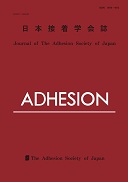All issues

Volume 42, Issue 12
Displaying 1-5 of 5 articles from this issue
- |<
- <
- 1
- >
- >|
Review
-
Masahiro MURAOKA, Ichiro YAMASHITA2006 Volume 42 Issue 12 Pages 527-532
Published: December 01, 2006
Released on J-STAGE: October 31, 2015
JOURNAL FREE ACCESSDownload PDF (2570K)
Review
-
Kazuyoshi IWANE2006 Volume 42 Issue 12 Pages 519-526
Published: December 01, 2006
Released on J-STAGE: October 31, 2015
JOURNAL FREE ACCESSDownload PDF (2617K)
Review
-
Yoshinobu NAKAMURA2006 Volume 42 Issue 12 Pages 513-518
Published: December 01, 2006
Released on J-STAGE: October 31, 2015
JOURNAL FREE ACCESSDownload PDF (2125K)
Original Paper
-
Masaki KAKUDA, Tatsuhiro TAKAHASHI, Ken MIYATA, Masataka SUGIMOTO, Tak ...2006 Volume 42 Issue 12 Pages 506-512
Published: December 01, 2006
Released on J-STAGE: December 31, 2014
JOURNAL FREE ACCESSTo investigate relationship between hot tack strength and entanglement behavior, two PSs (polystyrene) that having nearly equal molecular weight (Mw=2.0×105) but different molecular weight distribution (Mw/Mn=1.04 and 1.94) were used. Effects of molecular weight distribution on hot tack strength and rheological properties were discussed. Thin layered PS on PET (Poly (ethylene terephthalate)) film as the substrate was prepared using PS/THF (Tetrahydrofran) solution. Hot tack tests were performed under three different peeling rates at 140℃ with 1.0 to 100 sec of heat seal time for all tests. The surfaces after tests were observed by optical microscope. The number of newly generated entanglements on a polymer chain under several heat seal time was calculated by measuring dynamic shear viscoelasticity. As a result, we could determine critical generated newly entanglement number to show minimum hot tack strength. The critical value was about 0.02. PS having broad molecular weight distribution exhibited slightly lower critical value than that having narrow molecular weight distribution. In addition, the failure types were quantitatively classified based on the newly generated entanglement number.View full abstractDownload PDF (2487K)
Original Paper
-
Eka Mulya ALAMSYAH, Masaaki YAMADA, Kinji TAKI, Hiroaki YOSHIDA, Atsun ...2006 Volume 42 Issue 12 Pages 499-505
Published: December 01, 2006
Released on J-STAGE: December 31, 2014
JOURNAL FREE ACCESSIn continuation of our study into estimate potential bonding performance of bonded wood products from tropical fast growing tree species, a study on the bondability of Shorea sp, Acacia mangium Willd and Acacia hybrid from Malaysia was done. Two-ply laminations were produced using PVAc, UF, API and PRF adhesives. In order to determine the bonding performance, the block-shear test was applied according to JAS for structural glued laminated timber under normal conditions and after accelerated-aging treatments. Results showed that high percent wood failure of low-density Shorea sp indicated that the bondability of this species was far better than that of medium-density A. mangium and A. hybrid. Among the adhesives used in each wood species indicates that in Shorea sp and A. mangium, laminates bonded with UF, API and PRF seemed to have better bonding performance than PVAc. In A. hybrid, laminates bonded with API and PRF seemed to have better bonding performance than PVAc and UF.View full abstractDownload PDF (2709K)
- |<
- <
- 1
- >
- >|